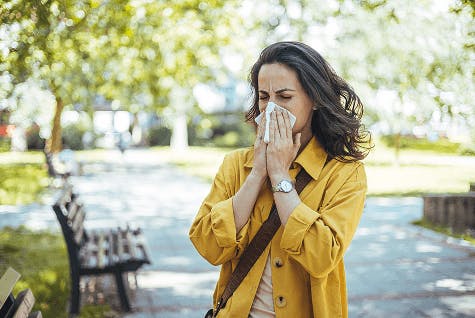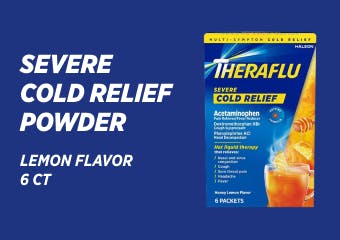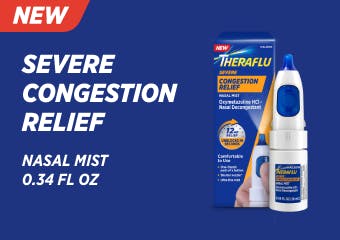If you’ve been trying to figure out whether what you’re experiencing is due to an allergy or a cold, you may need to consider your symptoms and when you experience them. Learn the difference between allergy vs cold symptoms and treat them accordingly with this guide from Theraflu.

Key Takeaways
- Symptoms between colds and allergies overlap. Both can produce sneezing, congestion, and a runny nose, making it difficult to distinguish between them.4
- Unique symptoms can help you tell them apart. Fever and sore throat are more common with colds, while itchy eyes are typical of allergies.4
- A decongestant nasal mist can help. Get fast-acting relief with Theraflu Severe Congestion Relief Nasal Mist.
What Causes Allergies
An allergy is an outsized immune reaction to a substance that is usually not harmful.1 Your immune system will typically protect the body against harmful substances like bacteria and viruses; it will also react to foreign substances known as allergens.1
What Are Common Allergens?
Someone with an allergy may be affected by allergens through skin contact, consuming something, inhaling something, or being injected.1
Common allergens include:1
- Insect venom
- Pollen
- Pet dander
- Animal scratches
- Latex
- Medication
- Certain foods
- Dust
- Mold or Mildew
For people with allergies, the immune system will react to allergens by releasing chemicals such as histamine, which prompt allergy symptoms.
How Do Allergens Affect Us?
Commonly, allergy symptoms will affect the part of the body that has come into contact with the allergen. For example:1
- If you scratch a cat and then touch your eyes, you may have itchy, watery or red eyes as a result.
- Eating peanuts when you have a peanut allergy may result in a life-threatening reaction where your throat swells up and restricts your airway. Other allergic responses to food may be less severe: nausea, cramping and abdominal pain.
- Inadvertently wearing latex gloves when you have a latex allergy can cause a skin rash or hives.
- Going outside during Springtime can cause you to inhale pollen, which can cause a stuffy nose or excess mucus.
What Causes a Common Cold
There are over 200 different viruses that can cause a common cold, with the most common being the rhinovirus.2 Once infected, a cold can affect your nose, sinuses, throat and windpipe, and can spread easily, especially when people are in close contact like homes, schools and workplaces.2
What is the Rhinovirus?
Rhinoviruses are viruses that affect the nose and are the most frequent cause of the common cold.3 These viruses can spread from person to person all year long, but are most common during the early fall or spring.3 There are currently no immunizations to prevent an infection from a rhinovirus.3
Preventing the Cold
Colds are highly contagious, they can spread easily from person to person.2 For a person to become infected, the virus must penetrate the moist tissues of your eyes, mouth or nostrils.2 Being near an infected person who is coughing means you may breathe in some of their droplets of fluid containing the virus.2
Thankfully, there are a few ways to prevent a cold:2
- Wash your hands. Wash them frequently, especially when you’re preparing or eating food, using the restroom, wiping your nose or coming into contact with someone who appears sick.
- Don’t touch your face. The virus can spread from your hands to your eyes, nose and mouth.
- Clean frequently used surfaces. A virus can live on a commonly used surface like a counter or a doorknob and then transfer to your hand, which may then touch your face.
Allergy vs. Cold Symptoms
Despite colds and allergies being caused by different things, they have a few similar symptoms. Thankfully, you can usually tell whether you’re experiencing the symptoms of a cold or a seasonal allergy by the type of symptoms you have and how often they show up.4
While there is a fair amount of overlap between the symptoms, there are also a few key differences: seasonal allergies are rarely accompanied by the sore throat and fever that may come along with a cold.4
We’ve created this helpful chart to help you learn whether you have an allergy or cold, based on your symptoms:4
| Symptom | Cold | Allergy |
|---|---|---|
| Fever | Sometimes | Never |
| Itchy Eyes | Rare | Common |
| Sneezing | Common | Common |
| Runny Nose | Common | Common |
| Nasal Congestion | Common | Common |
| Cough | Common | Rare |
| Sore Throat | Common | Rare |
Managing Nasal Congestion from Cold and Allergies
Nasal congestion is a common symptom of both the common cold and seasonal allergies, but thankfully it can be treated the same way no matter what’s causing it. Try using a decongestant to help relieve a stuffy nose.1
Get fast-acting relief from severe nasal congestion with Theraflu Severe Congestion Relief Nasal Mist. You’ll breathe better at the push of a button, whether you’ve got a cold or seasonal allergies, thanks to an ergonomic design with a side button that delivers a comfortable mist that unblocks in seconds.
Learn more about the differences between a cold, flu and allergies with this guide from Theraflu.





